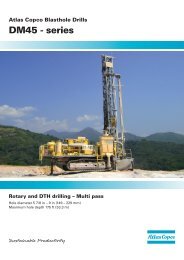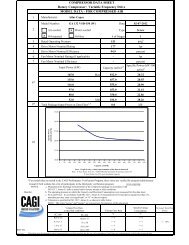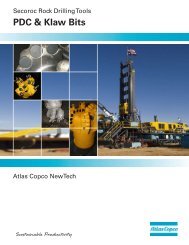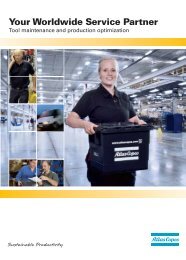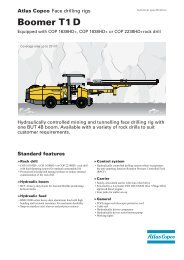Download - Atlas Copco
Download - Atlas Copco
Download - Atlas Copco
Create successful ePaper yourself
Turn your PDF publications into a flip-book with our unique Google optimized e-Paper software.
Compressed Air Supports the Rolling Road<br />
The Windshear rolling-road is manufactured by MTS<br />
Systems. The Single Belt FlatTrac® Rolling Road is<br />
elevated dozens of feet off the ground. The stainless<br />
steel track is 10.5 feet wide by 29.5 feet long and<br />
1 mm thick. The track “sits” upon a cushion of 150 psi<br />
compressed air. A key piece of technology is in the<br />
revolutionary “through-the-belt” sensing system, which<br />
directly measures the aerodynamic downforce produced<br />
by the vehicle.<br />
A series of air bearings keep the track “rotating”<br />
on the cushion of compressed air. Nozzles within the<br />
air bearings are also able to create an 8 degree angle<br />
which simulates the conditions when taking a turn on<br />
the racetrack. Downforce is provided by the wind tunnel<br />
blowing air on the car. The fan is twenty two (22)<br />
feet in diameter and is powered by a 5,300 horsepower<br />
motor. The fan is capable of generating winds of over<br />
180 mph.<br />
Left to Right: Carl Kline (Haas CNC Racing) and Jim Bruce (<strong>Atlas</strong><br />
<strong>Copco</strong>) with the on-site oil-free rotary screw compressors at<br />
Windshear Inc.<br />
Extremely sensitive pressure sensors (tolerance of ¼<br />
lb.) are able to measure and record the amount of downforce<br />
on the car. The static downforce is created by the<br />
weight of the car and the dynamic downforce is created<br />
by the resistance of the wind on the different parts of<br />
the car. The pressure sensors can measure this “drag” in<br />
various track configurations to see how well the car will<br />
perform.<br />
“Windshear told us they would be testing 4,550 lb.<br />
race cars, traveling at 180 mph, into a Hurricane Category<br />
4 headwind, and that they wanted their pressure<br />
sensors to measure pressure to the accuracy of ±¼ lb.,”<br />
said Jim Bruce, then Vice President Eastern Region at<br />
<strong>Atlas</strong> <strong>Copco</strong> who supplied the compressed air system.<br />
“We knew right then and there that we had to use Class<br />
Zero oil-free air compressors to protect the sensors.”<br />
Left to Right: Clinton Gentz (<strong>Atlas</strong> <strong>Copco</strong>), Brian Nelson (Windshear),<br />
and Jim Bruce (<strong>Atlas</strong> <strong>Copco</strong>) standing underneath the Rolling Road.<br />
Selecting the Class Zero Oil-Free<br />
Air Compressors<br />
The original specification stated “oil-lubricated compressors<br />
could be used if adequate oil removal filtration<br />
is provided - including oil vapor removal.” Clinton<br />
Gentz, <strong>Atlas</strong> <strong>Copco</strong>’s Oil Free Air Sales Manager based<br />
in Charlotte said, “We were able to show Windshear<br />
and MTS that the integrity (pressure measurement) of<br />
the whole Windshear project would depend upon the<br />
proper function and maintenance of several air treatment<br />
components if an oil injected screw compressor<br />
was used.”<br />
Windshear agreed to eliminate the potential of any<br />
compressor oil contamination arriving on the crucial<br />
porous carbon air bearings. “They knew it would be<br />
costly and devastating, and that ISO 8573.1 Class Zero<br />
air compressors were the right solution for their<br />
process,” said Gentz.<br />
Oil-Free Rotary Screw vs Oil-Free<br />
Centrifugal Air Compressor<br />
After it was agreed that Class Zero air was required,<br />
the question became whether to use a rotary screw or a<br />
centrifugal air compressor. Carl Cline was tasked with<br />
purchasing the compressed air system which would<br />
allow the rolling road to function. “<strong>Atlas</strong> <strong>Copco</strong> offers<br />
all the product technologies in question (lubricated<br />
screw, oil-free screw, and centrifugal compressors).<br />
We liked their unbiased product approach in advising us<br />
as to what the best system would be for Windshear. Our<br />
specification calls for 24/7 operation, 365 days a year.<br />
We also require that the air compressors provide ±1 psi<br />
tolerance of air pressure at the demanded air flow regardless<br />
of possible extreme temperature and humidity<br />
conditions.” It was also made clear that while the<br />
design spec called for full load capability during 8,760<br />
hours per year, it was expected to be an application with<br />
intermittent demand as the wind tunnel turned on and<br />
off during testing procedures.<br />
Dynamic (centrifugal) compressors are greatly<br />
affected by ambient and cooling water temperature.<br />
The performance of a centrifugal compressor is also<br />
diminished when forced to operate above its designed<br />
temperature conditions. Therefore, you must design a<br />
centrifugal compressor for the hottest expected ambient<br />
conditions to ensure adequate flow for the process in<br />
the summer months—which is fine until the colder fall<br />
and winter months come along. The colder temperatures<br />
cause the centrifugal to use more BHP thus creating<br />
more air flow which has to be “blown off” or<br />
wasted by venting it to atmosphere. The throttling<br />
range or partial load performance of a centrifugal compressor<br />
is limited to 15-20% of its full load capacity so<br />
when the demand is below the turndown range the air<br />
must be blown off in order to provide a constant<br />
delivery pressure.<br />
The selection of air-cooled compressors vs. water-cooled<br />
eliminated the potential consumption of 131.4 million gallons<br />
of water per year.<br />
13 <strong>Atlas</strong> <strong>Copco</strong><br />
Commitment 14




